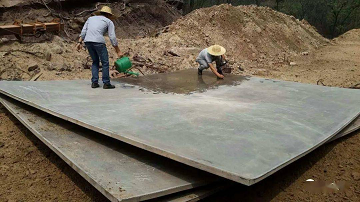ASTM A516 Gr.70 + Monel 400 Explosion Cladding Plates
SJZ Metalsin Tech Co LTD, through an American company, provides ASTM A516 Gr.70 + Monel 400 Explosion Cladding Plates to Saudi Arabian Oil Company (Saudi Aramco). Length is 2400mm, width is 1200mm. The base material is ASTM A516 Gr.70 with a thickness of 10mm, and the cladding material ASTM B127 Monel 400 plate has a thickness of 10mm. Saudi Aramco is a state-owned petroleum company headquartered in Saudi Arabia and is one of the world’s largest oil producers, possessing the world’s largest proven crude oil reserves. The company is engaged in petroleum exploration, extraction, processing, and sales, wielding significant influence in the international energy market.

Explosive cladding plate construction site.
Production Process
Explosion Bonded Clad Plate is a composite material formed by the explosion welding of two different metals or alloys. Below is a brief description of the production process of explosion bonded clad plates.
- Material Preparation: Begin by preparing two different metals or alloys to be bonded. Typically, one is the base metal and the other is the cladding material. These are usually in the form of metal plates or blocks.
- Surface Preparation: Clean and treat the surfaces of the base metal and cladding material to ensure good contact and bonding during the welding process.
- Stacking: Stack the base metal and cladding material according to the design requirements, usually placing the cladding material on the surface of the base metal.
- Assembly: Assemble the stacked metal plate components into a pressure vessel or other suitable device to ensure safety and control during the welding process.
- Explosion Welding: Place appropriate explosive charges at the interface of the assembled metal plate components. Then, under controlled conditions, detonate the explosive charges to generate a high-pressure shockwave that rapidly bonds the two metals or alloys together.
- Cooling: After explosion welding is completed, allow the clad plate to cool to room temperature to solidify the welded interface and ensure a strong bond between the metal or alloy materials.
- Post-Treatment: Perform any necessary post-treatments, such as trimming, cutting, heat treatment, etc., to meet the final product requirements.
Explosion-bonded composite plates offer a range of advantages, including strong bond strength achieved through the metallurgical bonding process, customizable configurations to meet specific requirements, and the ability to combine different materials to achieve desired properties like corrosion resistance and mechanical strength. They provide a cost-effective solution compared to solid metal plates while still delivering similar or improved performance. Additionally, composite plates are lighter in weight, making them suitable for applications where weight reduction is crucial, and they often exhibit enhanced properties such as durability, fatigue resistance, and impact resistance.
Mill Test Certificates
1) MTC of ASTM A516 GR.70 PLATE, including chemical compositions, mechanical properties and impact test, providing by Wuyang Iron and Steel CO., LTD;
2) MTC of Monel 400 Plate, including chemical compositions, mechanical properties and heat treatment, providing by NIPPON YAKIN KOGTO CO.,LTD;
3) MTC-of-cladding, including sheer strength, bond strength and ultrasonic test according to NB/T47002.2-2019B1 / ASTM A578 Class 1.
